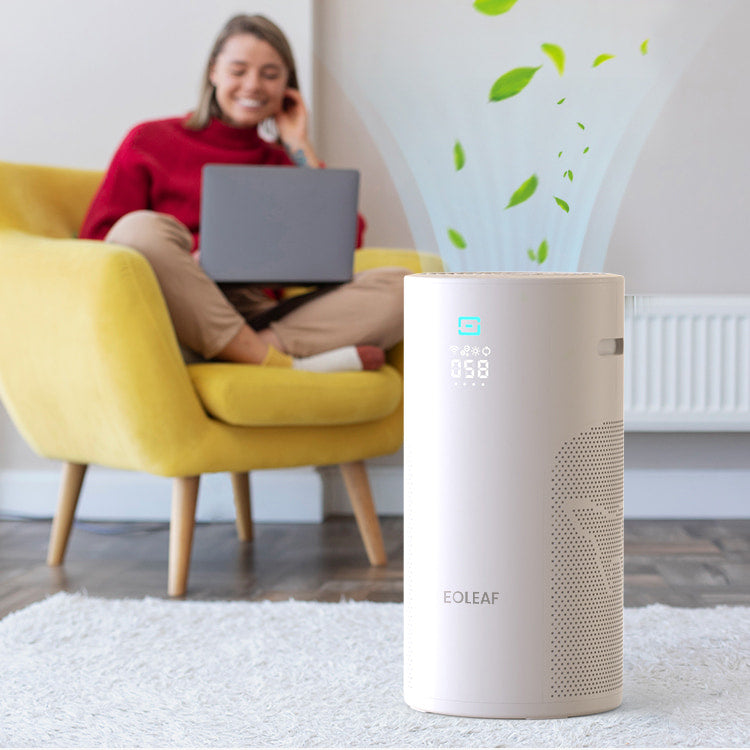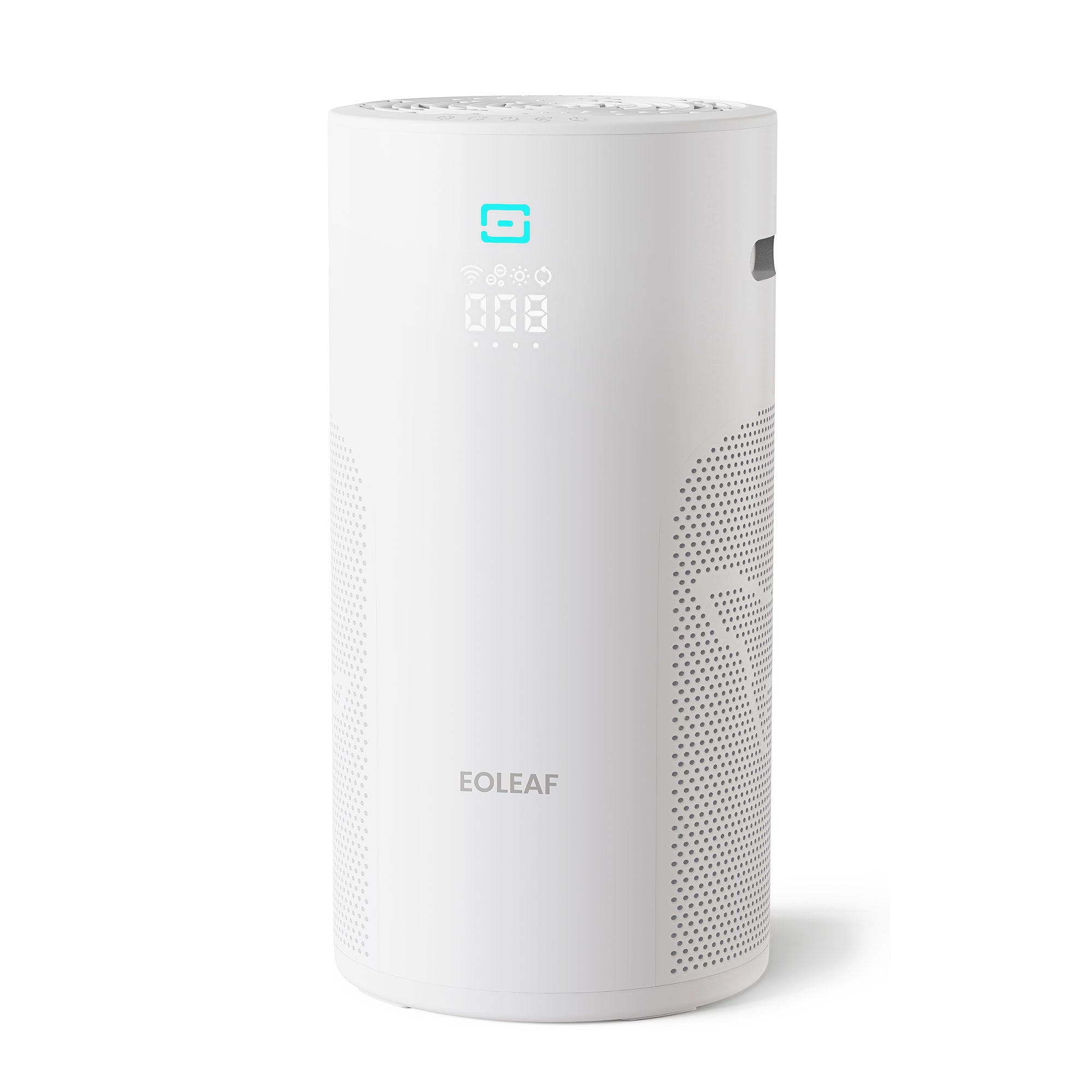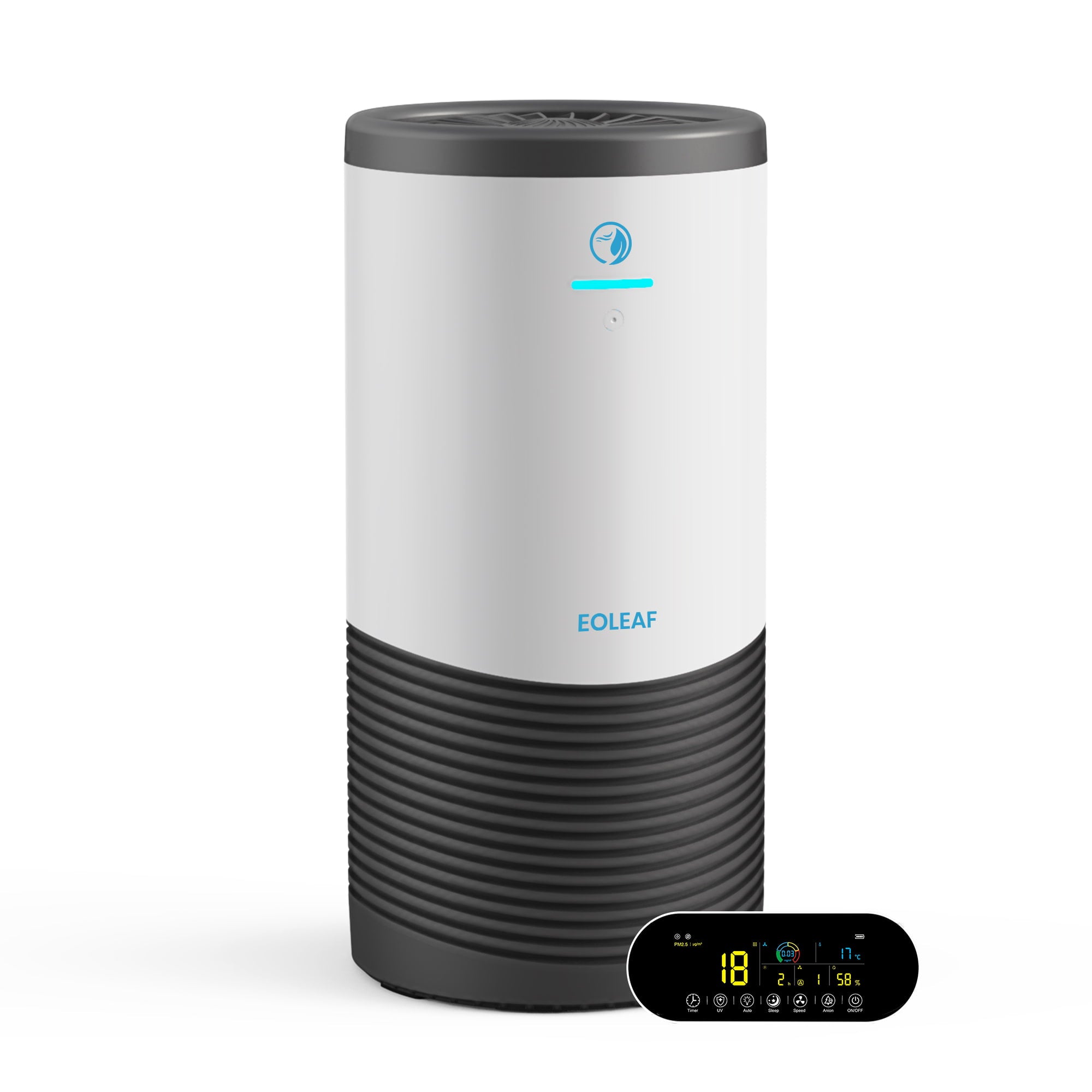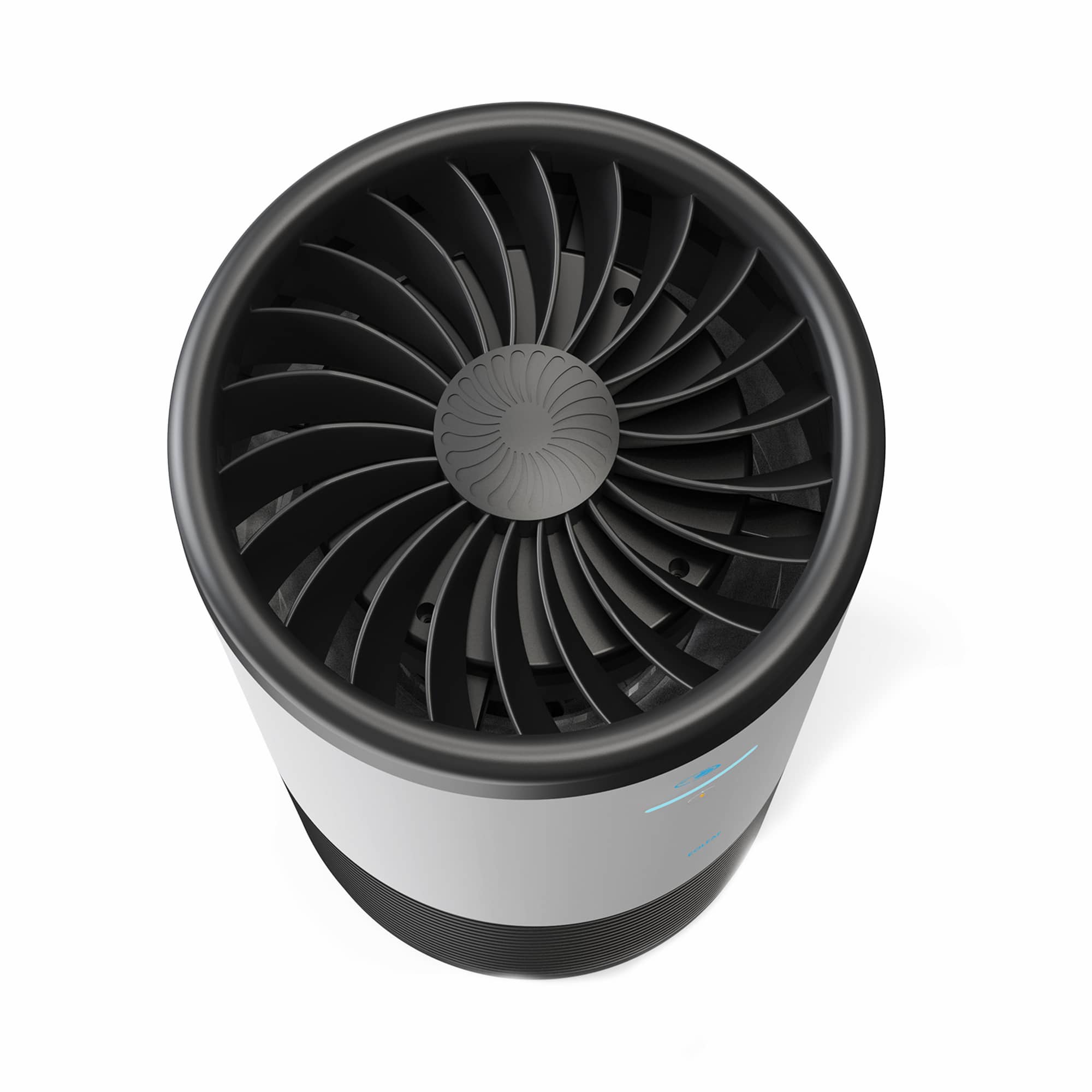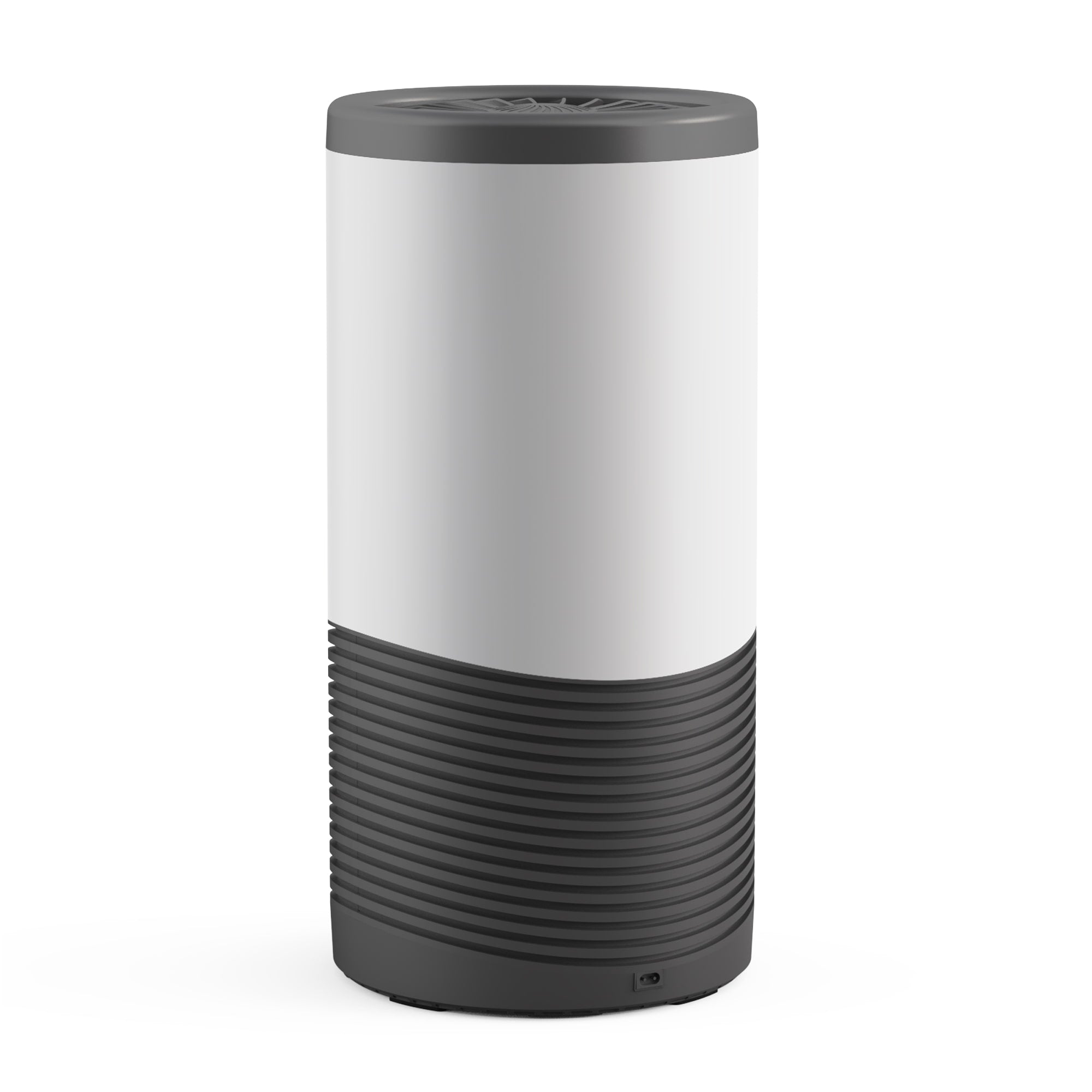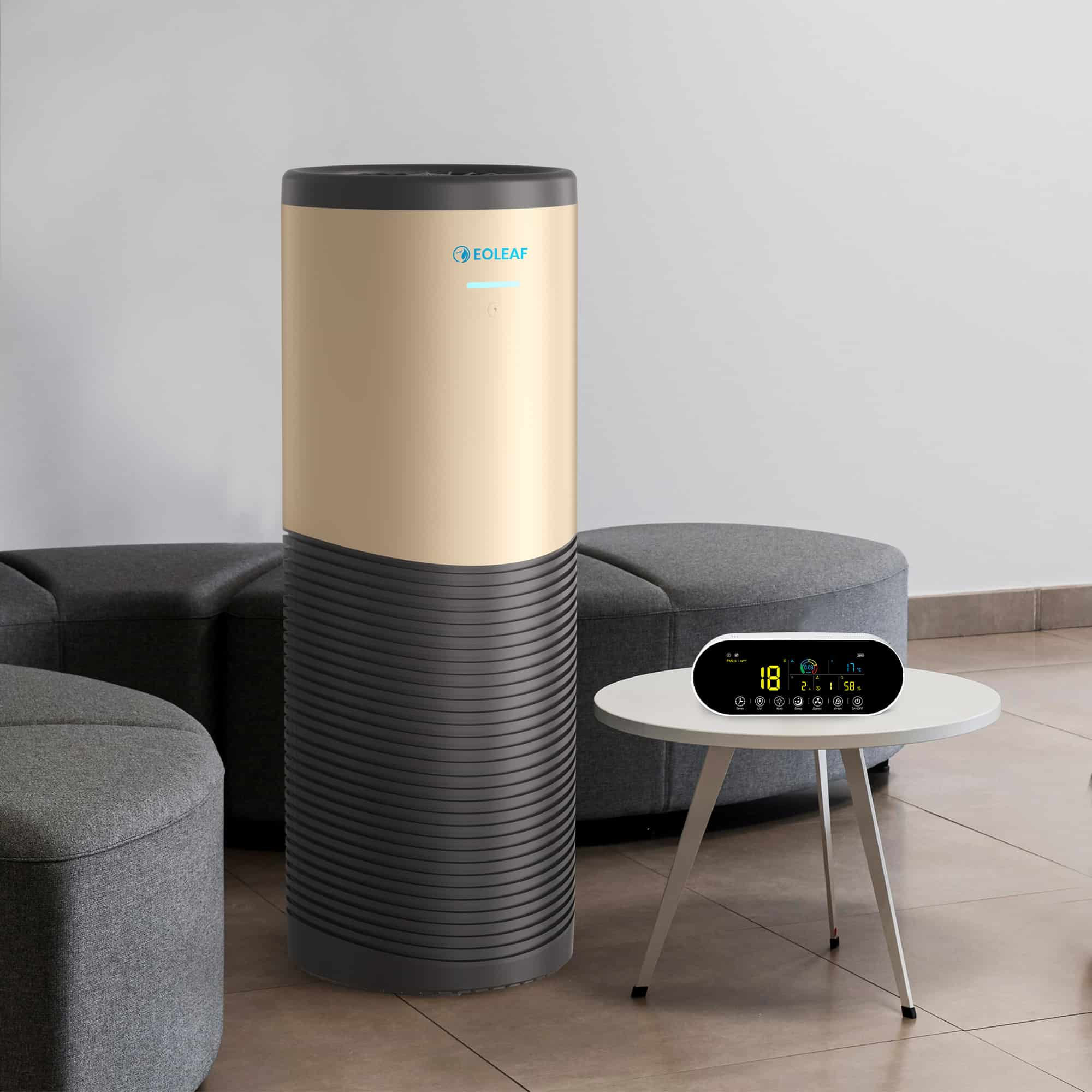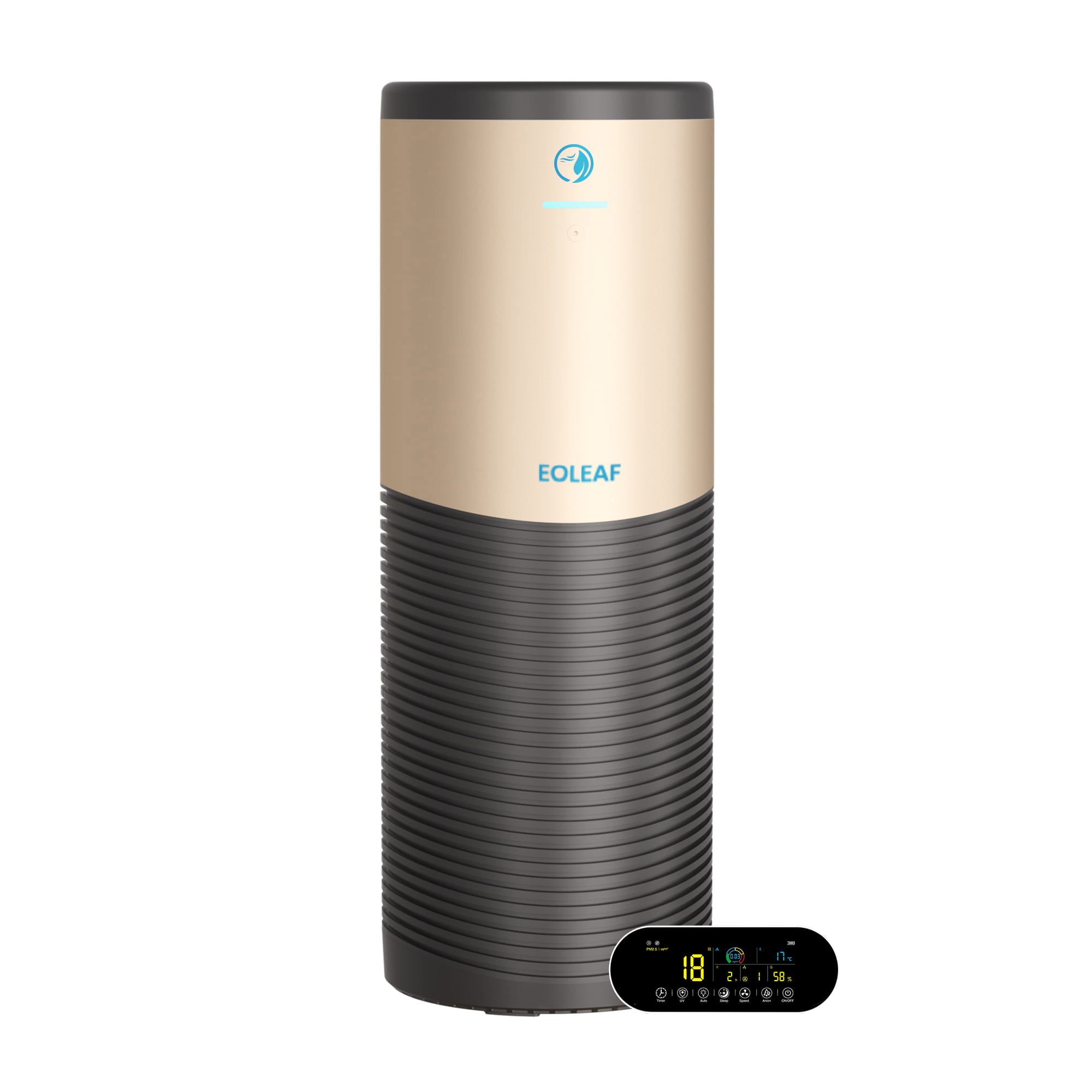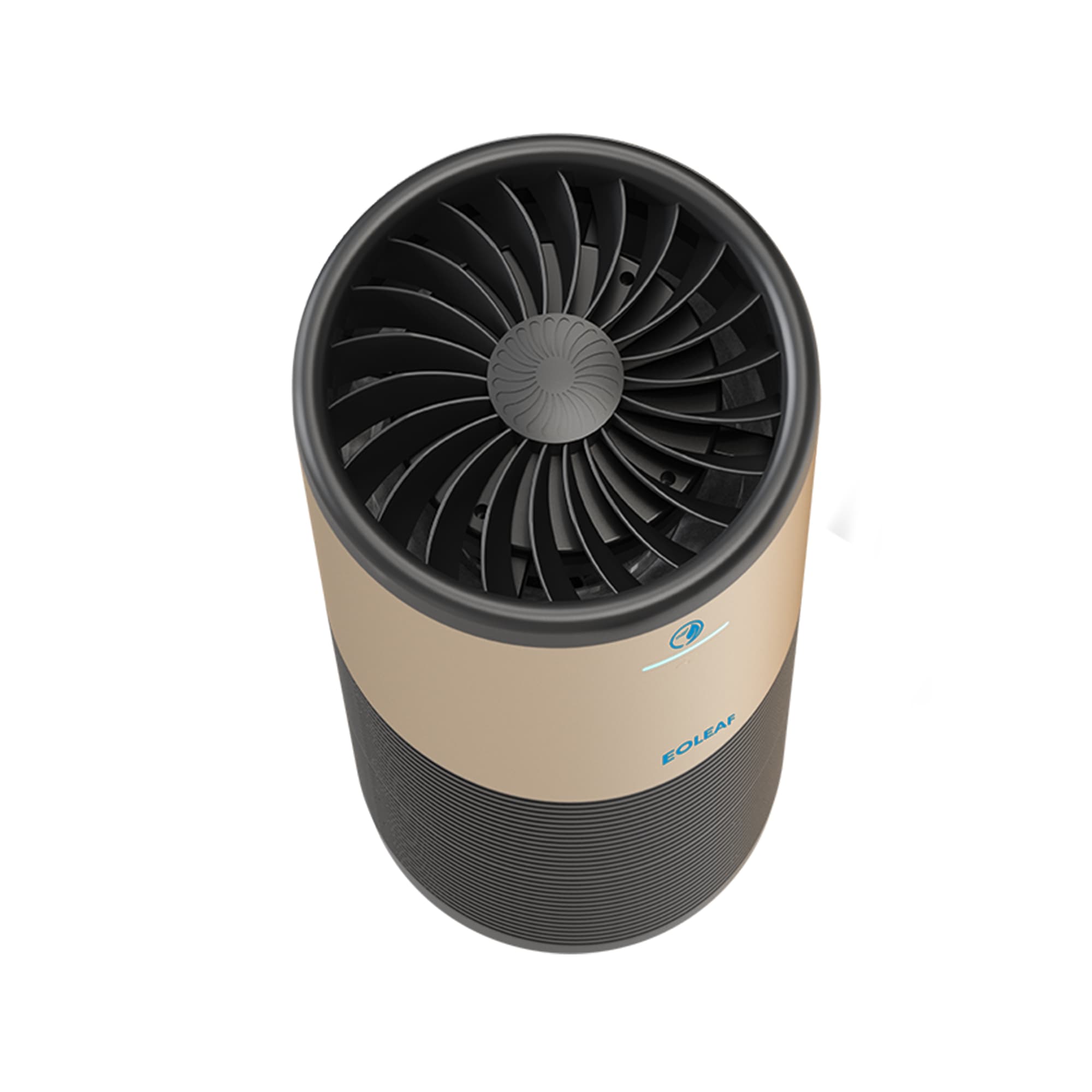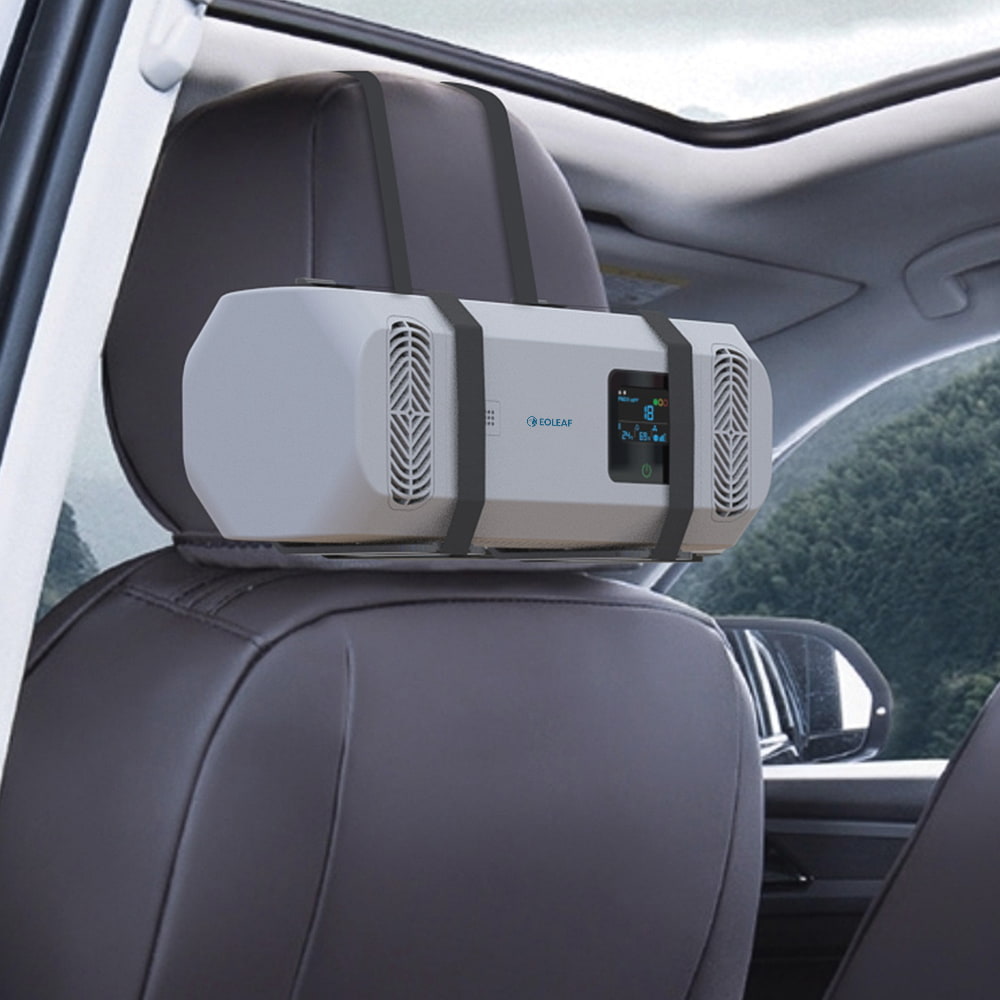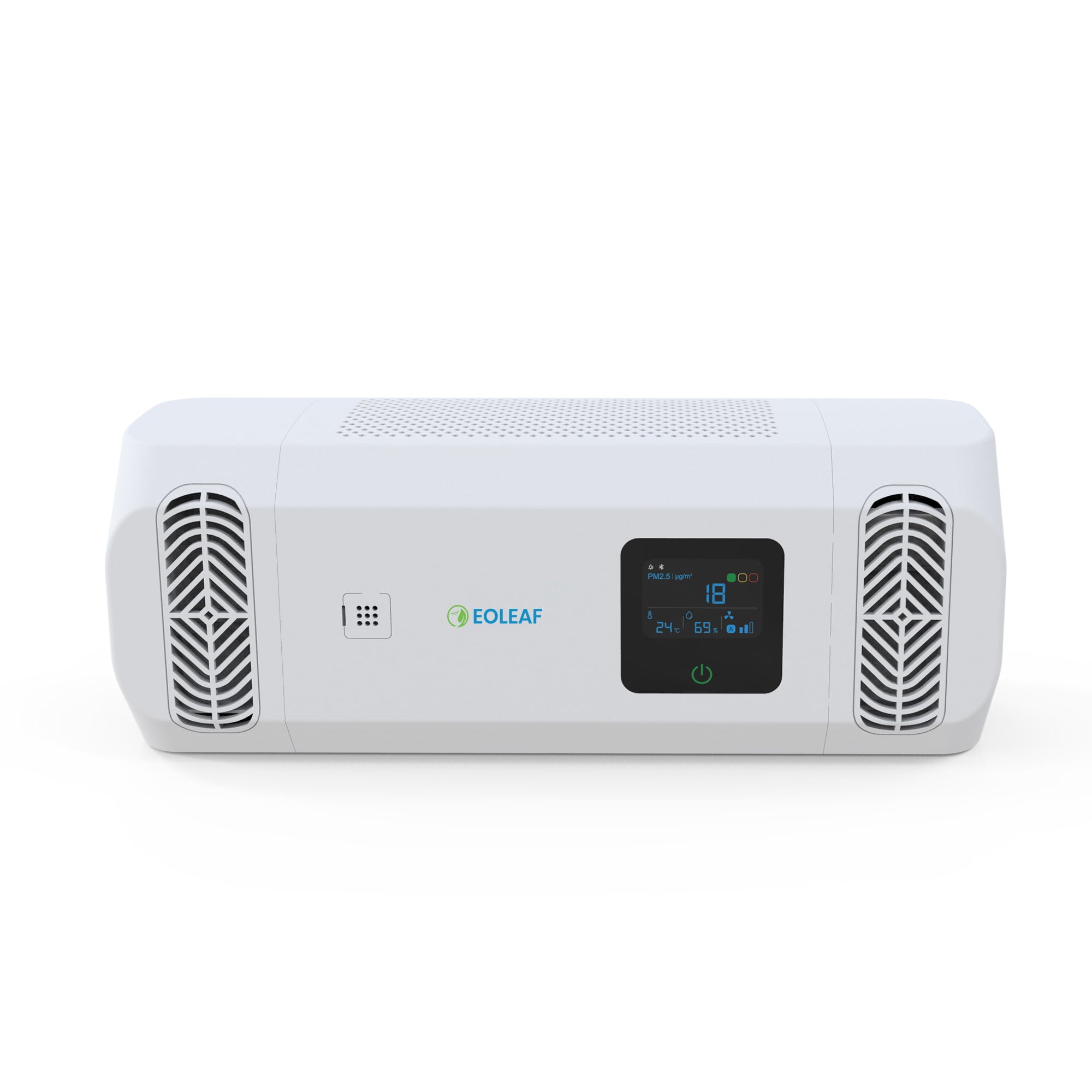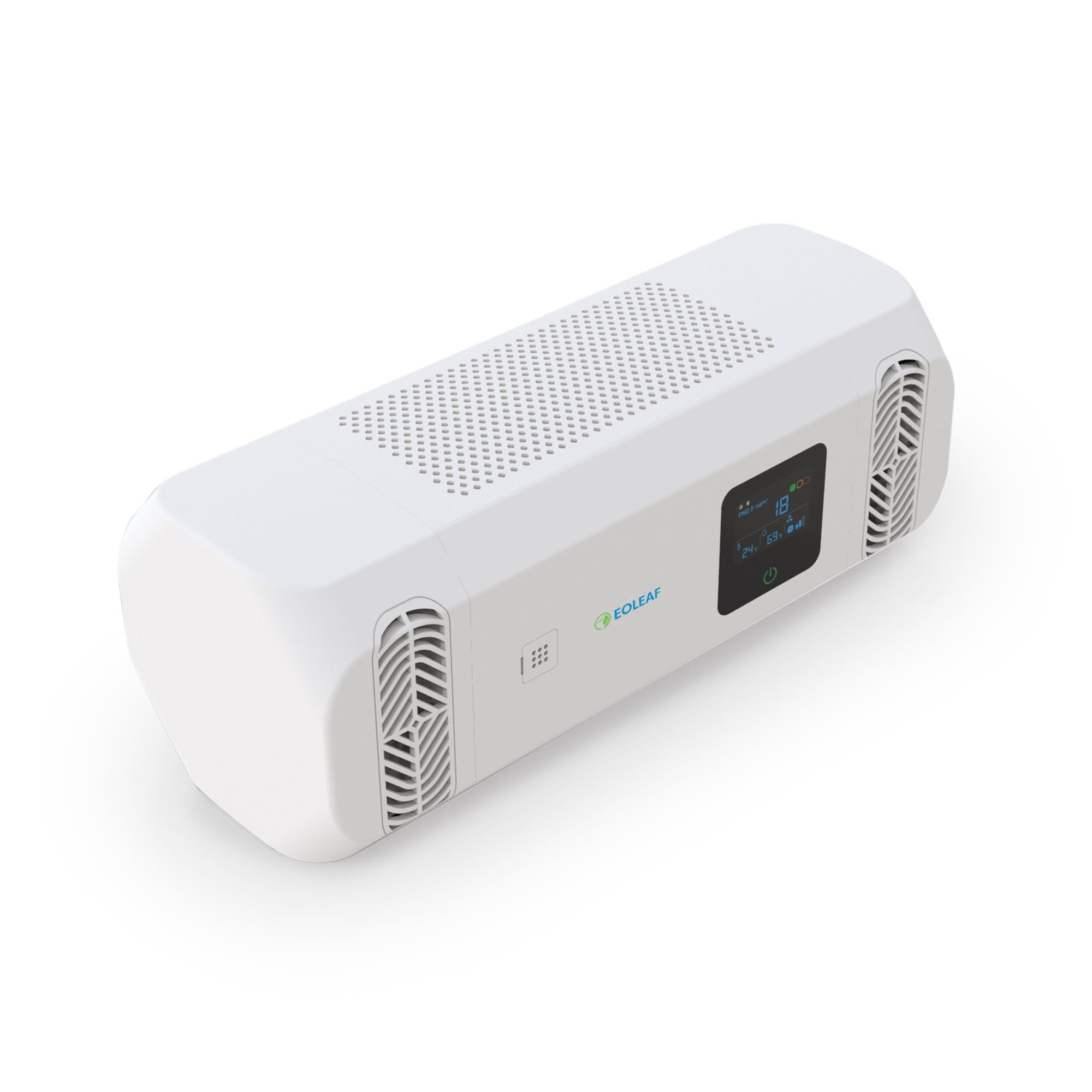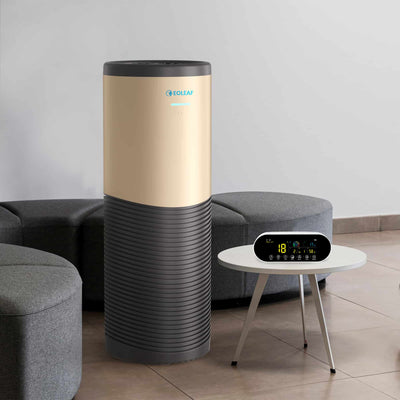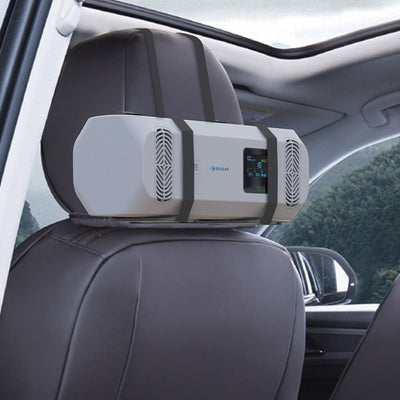Eoleaf vs. IQAir air purifiers
IQAir has become synonymous with high-quality air purification. The Swiss company specialises in air filtration products like air purifiers, HVAC solutions, air quality-measuring instruments, and has even created its own air quality monitoring platform. However, we have found some extremely misleading claims used on their website that make us question their marketing communication strategy and their transparency with their customers. Throughout this article, we will also be comparing the IQAir HealthPro 250 air purifier withthe Eoleaf TeraPur 600. Read on to learn more.

IQAir: technical expertise or gaslight marketing?
Throughout our research, we came across an article posted on the IQAir website discussing and criticising industry-wide air filter ratings1. Throughout the air filtration industry, certain big industry players (like Dyson, Levoit, and Blueair) refuse to use certain industry standards, claiming that they are ‘insufficient’ or ‘invalid methodologies’. Here are some of the inconsistencies we have found throughout the industry:
- Dyson refuses to use CADR, using their own, patented POLAR technology instead
- Philips, surprisingly, has major calculation errors on their website regarding room size filtration capacity, accidentally using room volume (m3) and not surface area (m2), which cuts their products’ room size filtration capacity claims in half
- Levoit, following a dispute brought forward by Dyson stating that their products do not hold up to HEPA standards, having previously used the acronym “HEPA” throughout its website, Levoit removed all mentions of HEPA certification from its website
- Blueair refuses to adhere to HEPA certification, using its own trademarked ‘HEPASilent’ technology; they also provide multiple room sizes for their products, creating confusion amongst consumers
As with all young markets that do not yet have sufficient regulation, big players feel that they are above any and all accountability. IQAir, unfortunately, is no exception. IQAir uses confusing sales and marketing rhetoric, deviates from accepted industry standards, and does not make basic numerical performance data for their devices readily available.

Claim #1: No independent body is required to test or verify the HEPA claim
This is true. This makes choosing an air purifier difficult for consumers because air purifier manufacturers can make whatever claims they’d like without being held accountable. The terms ‘HEPA-type’, ‘HEPA-style’, ‘HEPA-like’, and even company-patented terms like ‘HEPASilent’ (as coined by Blueair) or ‘HyperHEPA’ (as coined by none other than IQAir!) are not guaranteed by third parties for their efficiency. This is why it is so important to seek out a device that clearly states that it is ‘HEPA-certified’ or ‘True HEPA’: these are tested for efficacy by third-party laboratories and agencies.
However, IQAir is quick to denounce other companies’ technologies containing the phrase ‘HEPA’, specifically mentioning Blueair’s ‘HEPASilent’ technology. IQAir does exactly the same thing: their patented technology is called ‘HyperHEPA’. Compared to Blueair’s air purifiers, IQAir’s air purifiers do seem to undergo third-party testing and adhere to HEPA standards according to their website.
Claim #2: CADR does not test effectiveness for harmful gases, chemicals, and odours
This is only partially correct. By default, CADR tests effectiveness against fine particles only. However, different CADR exist for multiple types of air pollution: CADR_PM2.5 for fine particles, for example, is a common one, but certain brands (as is the case with Eoleaf) also offer specific CADR for individual types of pollution and allergens like pollen and dust (for those with severe allergies, for example). There is also a CADR_HCHO which does measure effectiveness on filtration of chemical pollution (ozone, VOCs, carbon monoxide, gaseous pollutants, etc).
Claim #3: CADR does not distinguish whether an air purifier eliminates particles or deposits them on room surfaces
This is true, which can be an issue for ioniser-only devices. This is why Eoleaf air purifiers, which are 2-in-1 air purifiers/ionisers, are ionisers equipped with a filter.
Claim #4: CADR does not measure ozone filtration or production
This goes in line with claim #2 and is only partially correct. Ozone is a type of gaseous air pollution. As mentioned above, there are multiple types of CADR, some of which do measure ozone and other gaseous pollutants.
By default, CADR is simply a measurement for a single type of pollutant (fine particles). Generally speaking, there is no single, all-encompassing metric that can summarise all the characteristics of an air purifier. For example, CADR does not measure noise level or power consumption (the NF standard does), but that is not the purpose of CADR: the goal is to measure the flow rate of purified air. There are other metrics and measurements that complement CADR.
Cumulate Clean Mass (CCM), which is championed by IQAir, measures the durability of a filter's performance. CCM is a metric that Eoleaf publishes for each of its devices. But, like all other metrics (including CADR), it only provides a partial view of an air purifier's performance, which, by nature, is multifactorial. IQAir pitting CADR and CCM against each other is like comparing apples and oranges. This demonstrates, in our opinion, a desire to sow confusion and a desire to avoid direct numerical comparisons with high-performance air purifiers from other brands. This desire is shared by many other industry leaders who never make all their numerical data readily accessible.
Conversely, Eoleaf publishes all the numerical data on the product sheets for its Eoleaf air purifiers: the CADR for each speed and type of pollution (fine particles and chemical pollution), the CCM for each type of pollution, the HEPA H13 certification, and the ozone-free certification.
Claim #5: The best-case scenario for filters that actually do achieve the HEPA standard is to filter particles down to 0.3 microns at 99.97% efficiency
This is completely false. This is a blatant misunderstanding of how the HEPA test protocol works and is, frankly, baffling to see written by an industry leader. It is true that particles of 0.3 microns are used as a reference during HEPA certification procedures because particles of 0.3 microns are referred to as ‘MPPS’ (the most penetrating particle size) and, as a result, are the most difficult to filter. Although it may seem counterintuitive, it has been established that particles of 0.3 microns are more difficult to filter (called MPPS) than particles of a smaller size because they are small enough to pass through an air purifier’s filter’s mesh but still big enough to have high momentum (which is proportional to the particle’s mass).
In summary: the European standard EN 1822 bases its testing on particles of 0.3 microns because they are the most difficult size to filter, not the smallest. NASA published a study in 2016 showing that HEPA filters are extremely effective in capturing particles of varying sizes, capturing a high percentage both particles larger than 0.3 microns and nanoparticles down to 0.01 microns. Read more here.
Claim #6: IQ Air's technology is able to filter ultrafines down to 0.003 microns– that’s ten times smaller than most viruses
This claim is misleading. Indeed, in real-world conditions, a virus never travels alone. It is found in aerosols (or respiratory droplets) which are much larger than a single virus. To put this into perspective, a single cough generates 3000 droplets, approximately 360 droplets contain viruses, and these virus-containing droplets contain 9800 viruses2. While these droplets are still extremely small (measuring around 5 to 10 microns3), they are big enough to be filtered by standard HEPA filters. This type of statement is misleading and disparaging to the HEPA industry norm.
Furthermore, it is not without irony that the ‘HyperHEPA’ technology trademark registered by IQAir itself relies on and cites the European HEPA EN1822 standard, as can be seen on this page.
Claim #7: Any calculation based on a CADR rating is invalid, and IQAir does not consider CADR to be a valid methodology for evaluating air purifiers
This claim is completely false. Using CADR and room volume to size a project is the industry standard, and there is no alternative. CADR provides an accurate picture of an air purifier's effectiveness and is only supplemented by CCM regarding the durability of that performance. This is why CCM is a qualitative metric (a class) and not a numerical one.
Regarding the second part of this statement, CADR is a recognized and universally-applied industry standard. It is a numerical metric that, while it has some limitations, as mentioned above, is extremely useful for consumers to easily evaluate and compare different models and brands of air purifiers based on purification efficiency. CADR does not provide a complete assessment of an air purifier (no single metric could) and has never claimed to do so. CADR does not test all aspects of an air purifier and can certainly be improved, but it serves an important role in giving customers transparency and the ability to use hard data to compare efficiency for themselves.
Overall, we found this article misleading and view it as a marketing ploy. Ironically enough, their article finishes with: ‘Arm yourself with the knowledge you need to make an informed decision. And remember to look beyond the marketing jargon and flawed test processes’.
Comparing the IQAir HealthPro 250 air purifier and the Eoleaf TeraPur 600
Now, let’s move on and take a closer look at comparing the IQAir HealthPro 250 with the Eoleaf TeraPur 600. How do these two devices compare in improving indoor air quality?
|
IQAir’s HealthPro 250 |
Eoleaf’s TeraPur 600 |
|
|
Price |
£999 (1299 €) |
£629 (749 €) |
|
Technologies |
Pre-filter, gas and odour filter, HEPA filter |
Pre-filter, bamboo fibre filter with antibacterial coating, HEPA filter, activated carbon filter, photocatalysis, UVC sterilisation, ionisation |
|
HEPA filter |
Yes, HyperHEPA H12/13 filter |
Yes, medical-grade H13 filter that captures 99.97% of pollutants down to a size of 0.01 microns |
|
Activated carbon filter |
Yes, V5-Cell Filter MG with granulated activated carbon and impregnated activated alumina |
Yes, weight of 0.64 kg |
|
CADR |
Not communicated |
570 m3/h |
|
Air circulation angle |
320° |
360° |
|
Fan speeds |
6 |
5 |
|
Standby power consumption |
<1W |
<2W |
|
Min and max noise level |
22 dB (speed 1) to 57 dB (speed 6) |
30 dB (speed 1) to 60 dB (speed 5) |
|
Filter lifespan |
12 to 48 months depending upon the filter layer |
Up to 12 months |
|
Weight |
16 kg |
9.4 kg |
|
Size (H x W x L) |
H 71 x W 38 x L 41 |
31.25 cm (diameter) x 62.70 cm (height) |
|
Room size |
Not communicated |
0 to 80 m2 |
|
Smart features |
Yes, remote control, advanced timer, advanced fan speed selection, intelligent filter life monitor |
Yes, filter life indicator, connectivity with the Tuya Smart app, Bluetooth terminal remote control display, voice commands, gesture controls, wheels |
|
Warranty |
10 years excluding labour if purchased directly through IQAir |
2-year Limited Warranty |
Performance
IQAir HealthPro 250
The IQAir HealthPro 250 is touted as IQAir’s best ‘all-around’ air purifier. Yet, this device only offers the three classic air purification technologies: a pre-filter, a chemical pollution filter (activated carbon), and a HEPA-certified filter (H12/13). Although these technologies are effective in improving air quality, for a device at this price point, we certainly expected more comprehensive performance against indoor air pollution in an IQAir air purifier. The IQAir HealthPro 250 is on offer for £999 or 1299€ (according to various IQAir distributors’ websites since IQAir air purifiers are not available for sale on their website).

We are not quite sure what it means when IQAir claims that this device offers a HEPA H12/13 filter (HEPA certification results in the allocation of a unique class). Only HEPA H13 and H14 filters are considered to be ‘medical-grade’, so this creates a bit of confusion. As discussed above, we do not know how efficient this device is since there is no CADR. We do not know the room size that this IQAir air purifier covers since it would require CADR to calculate.
Eoleaf TeraPur 600
We value transparency, so all of the technical information regarding our devices is made readily available to all our customers. Our price point is significantly more accessible at nearly half the price of the IQAir HealthPro 250: the Eoleaf TeraPur 600 is available for £629 or 749€, purchasable directly on our website. The Eoleaf TeraPur 600 offers the same air filtration technologies as the IQAir HealthPro 250, as well as 5 more as part of our proprietary multi-layer filtration technology:
- Pre-filter
- Bamboo filter with an antibacterial coating
- Medical-grade HEPA H13-certified filter
- Activated carbon filter
- Photocatalysis technologies
- UVC sterilisation technologies (an essential technology for targeting germs and for sterilising the filter once it has captured air pollutants, reducing potential health risk)
- Ozone-free ionisation (negative ions)
Eoleaf air purifiers offer impressive CADRs with the TeraPur 600 boasting a CADR of 570 m3/h. It filters the air in medium-sized spaces of up to 80 m2 with an air outlet of 360° for optimal air circulation. Our medical-grade HEPA H13-certified filters remove 99.97% of all air pollutants down to a size of 0.01 microns, providing a comprehensive air quality improvement solution.

Usability and connectivity
IQAir HealthPro 250
The IQAir HealthPro 250 has a smaller air inlet (320°) than the Eoleaf TeraPur 600 (360°). The noise levels between the IQAir HealthPro 250 and the Eoleaf TeraPur 600 are comparable, but the HealthPro 250 offers one more fan speed setting than the TeraPur 600 (6 instead of 5). The HealthPro 250 is almost twice the weight of the TeraPur 600 at 16 kg and is bulkier, measuring about 10 cm higher than the TeraPur 600 at 71 cm.
The IQAir HealthPro 250 offers some limited smart features like a programmable timer, a programmable fan speed (day and night), and a filter lifetime and status monitor. It also offers four language choices for its display. However, it does not offer an Automatic mode, Night mode, app compatibility, or voice or gesture controls. Again, at the price point at which this IQAir purifier is on offer, the lack of smart features is surprising.

Eoleaf TeraPur 600
The Eoleaf TeraPur 600 offers a 360° air outlet for optimal air circulation and performance in your space. It is more compact and lighter than the IQAir HealthPro 250, weighing in at 9.4 kg with a height of 62 cm. This and the fact that it is equipped with wheels make it extremely portable and easy to move to another room if needed.
Eoleaf air purifiers are chock full of smart features that make monitoring and managing your air purifiers straightforward. Our devices offer smart scenarios like smart scenarios and programming and filter status indicators. They also come equipped with an Automatic mode that adjusts the fan speed automatically when new incoming pollutants are sensed and once they are cleared from your space. Our Night mode allows you to sleep soundly all whilst breathing purified air: the device dims all of its indicator lights and runs on its lowest fan speed. Furthermore, the TeraPur 600 offers app compatibility with the Tuya smartphone app for real-time air monitoring and controlling your device from a distance. Voice and gesture controls are the cherry on top, providing users with two hands-free control options.

Maintenance and warranty
IQAir HealthPro 250
The IQAir HealthPro 250 contains three filtration technologies and three separate filters. This adds some difficulty when planning your maintenance schedule as you need to change each of them at separate times. Filter lifespan for each of their filtration technologies is as follows:
- Pre-filter: 12 to 18 months
- Gas and odour filter: 15 to 21 months
- Particle filter: 36 to 48 months
The gas and odour and the particle filters have an impressively long lifespan, but again, performing filter changes requires significant organisation and budget. The IQAir website advises the customer to ‘plan accordingly for your replacement filters to avoid waste’.
In Europe and the UK, none of the filters for IQAir air purifiers are available for sale on their website. You must go through a distributor to make your purchase, but we found it difficult to find distributors that still offer filters. According to two distributors’ websites, one in the UK and one in France, replacement filter pricing is as follows:
- 3-filter bundle: £379 (not available in France)
- Pre-filter: £109 (79€ in France)
- V5-Cell MG gas and odour filter: £119 (139€ in France)
- HyperHEPA particle filter: £179 (179€ in France)
IQAir warranty terms are a bit unclear. Customers have left comments on the IQAir website stating that they were unsure of the warranty terms’ duration. After having submitted the online warranty registration form, they had not received a response from IQAIR to register their device. Still without a response, they attempted to contact IQAir customer service multiple times and were systematically told someone would reach out regarding their warranty, but no one ever did. A representative responded to the customer’s review on the IQAir website stating that ‘as long as the device was purchased directly from IQAir, you should be covered by our 10-year limited warranty’. Does this include obligatory purchasing through a distributor in Europe? We’re not sure.

Eoleaf TeraPur 600
Performing filter changes for the Eoleaf TeraPur 600, as well as all Eoleaf air purifiers, is extremely straightforward. Our filters contain all 8 technologies within one convenient filter block which requires replacing once per year. Replacing the filter takes less than one minute, can be performed by anyone, and can be purchased directly on our website. The TeraPur 600 replacement filter costs £129.99.

Eoleaf is here to provide you with the best air filtration on the market
Our team aims to help you protect your health from the dangers of indoor air pollution. We offer the most advanced home and professional air filtration technology on the market. We publish all of our data and certifications transparently and do not try to trick you with invented terms and trademarks. We've published over 200 articles in our Learning Centre with the aim of equipping everyone with the knowledge they need to make an informed choice. Reach out to our team today to help you choose the perfect device for your air purification needs.
FAQs
Does the IQAir HealthPro 250 need expensive, regular filter replacements?
All air purifiers require regular filter changes. The IQAir HealthPro 250 has three separate filters, all requiring changes at varying intervals. This requires some impressive organisational skills in order to keep track of when each filter needs to be changed. Filter change schedules and pricing are as follows:
- Pre-filter: 12 to 18 months, £109 (79€ in France)
- Gas and odour filter: 15 to 21 months, £119 (139€ in France)
- Particle filter: 36 to 48 months, £179 (179€ in France)
- 3-filter bundle: £379 (not available in France)
In the UK, this equates to a budget of £407 when purchased separately, or £379 when purchased in a 3-filter bundle. When taking the lifespans of each filter into account, this makes for a budget range of £204-264 per year.
In France, this equates to a budget of 397€. Since there is no 3-filter bundle available on the French market, this makes for a budget range of 180-252€ per year.
When operating, how noisy is the IQAir HealthPro 250, particularly when the fan speed is higher?
Despite being twice the price, noise levels of the IQAir HealthPro 250 are nearly identical to those of the TeraPur 600 as seen below:
- Speed 1: 32 dB for the IQAir HealthPro 250 versus 30 dB for the TeraPur 600
- Speed 2: 43 dB for the IQAir HealthPro 250 versus 45 dB for the TeraPur 600
- Speed 3: 51 dB for the IQAir HealthPro 250 versus 53 dB for the TeraPur 600
- Speed 4: 57 dB for the IQAir HealthPro 250 versus 57 dB for the TeraPur 600
- Speed 5: 62 dB for the IQAir HealthPro 250 versus 60 dB for the TeraPur 600
- Speed 6: 67 dB for the IQAir HealthPro 250 (the TeraPur 600 does not have a 6th fan speed)
When compared to other air purifiers on the market, how energy-efficient is the IQAir HealthPro 250?
For a device that is twice the price of an Eoleaf device, consumers of an IQAir device can also expect to consume twice the amount of energy. The IQAir HealthPro 250, on average, consumes more than twice the amount of energy as the TeraPur 600 at each fan speed:
- Speed 1: 20 W for the IQAir HealthPro 250 versus 10.1 dB for the TeraPur 600
- Speed 2: 36 W for the IQAir HealthPro 250 versus 13.5 dB for the TeraPur 600
- Speed 3: 54 W for the IQAir HealthPro 250 versus 19.2 dB for the TeraPur 600
- Speed 4: 74 W for the IQAir HealthPro 250 versus 35.8 dB for the TeraPur 600
- Speed 5: 105 W for the IQAir HealthPro 250 versus 56.8 dB for the TeraPur 600
- Speed 6: 135 W for the IQAir HealthPro 250 (the TeraPur 600 does not have a 6th fan speed)
How well suited is the IQAir HealthPro 250 for rooms with lots of space or open layouts?
We do not know. IQAir refuses to adhere to CADR standards which are used to calculate the room size capacity of an air purifier. Consumers who purchase this device run the risk of having a device that is either undersized for their space, meaning that not all of the air will be properly filtered, or oversized, meaning that the device will work harder and consume more energy than necessary, leading to earlier wear-and-tear on the device’s motor.
Resources
1 Which air filter rating should you trust?. IQAir. (2018, October 18). https://www.iqair.com/gb/newsroom/air-purifier-ratings
2 Wang Y, Xu G, Huang YW. Modeling the load of SARS-CoV-2 virus in human expelled particles during coughing and speaking. PLoS One. 2020 Oct 30;15(10):e0241539. doi: 10.1371/journal.pone.0241539. PMID: 33125421; PMCID: PMC7598485.
3 Cuffari, B. (2021, February 15). The size of SARS-COV-2 and its implications. News Medical. https://www.news-medical.net/health/The-Size-of-SARS-CoV-2-Compared-to-Other-Things.aspx
Eoleaf's range of air purifiers
NeoPur 400 air purifier
40 m² (450 sq ft) coverage area - Smart & Connected
TeraPur 600 air purifier
80 m² (850 sq ft) coverage area - Ultimate all-in-one
AltaPur 700 air purifier
120 m² (1300 sq ft) coverage area - Professional model
PurCar air purifier
HEPA H13 Filter & Ioniser - For all vehicles

